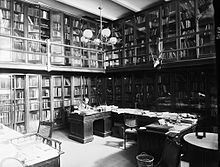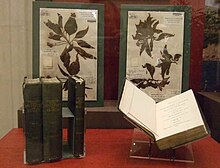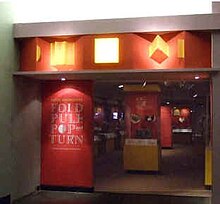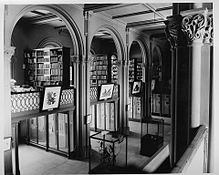Smithsonian Libraries
 | |
| Established | First library established 1846 Modern SIL system established 1968[1] |
|---|---|
| Location | Washington, DC; New York City, NY; Suitland and Edgewater, MD; Republic of Panama |
| Branches | 20 |
| Collection | |
| Size | 2 million volumes[2] |
| Other information | |
| Director | Nancy E. Gwinn |
| Website | library |
| Map | |
 | |
Smithsonian Libraries (SIL), formerly known as Smithsonian Institution Libraries, is a library system comprising 20 branch libraries serving the various Smithsonian Institution museums and research centers, as well as central support services which include a Book Conservation Laboratory and an Imaging Center. The Libraries serve Smithsonian Institution staff as well as the scholarly community and general public with information and reference support. Its collections number over 1.5 million volumes including 40,000 rare books and 2,000 manuscripts. The Libraries also holds the United States' largest trade literature collection, which includes over 300,000 commercial catalogs dating from the early nineteenth century and representing more than 30,000 companies.[1][3]
The Libraries' collections focus primarily on science, art, history and culture, and museology.[4] SIL is continuously analyzing its mission and goals in order to best meet the information and knowledge needs of new generations of users, to strengthen research, and to reach through cyberspace those unable to visit the Smithsonian museums and research centers in person.[5]
The shared SIL Catalog[6] is part of the Smithsonian Research Information System (SIRIS) from which one can search 1.89 million records of text, images, video and sound files from across the Smithsonian Institution.
In 2008, SIL celebrated its 40th anniversary. Nancy E. Gwinn, PhD, was named director in 1997.[7]
Mission[]
As the largest and most diverse museum library in the world, SIL leads the Smithsonian in taking advantage of the opportunities of the digital society. SIL provides authoritative information and creates innovative services and programs for Smithsonian Institution researchers, scholars and curators, as well as the general public, to further their quest for knowledge. Through paper preservation and digital technologies, SIL ensures broad and enduring access to the Libraries’ collections for all users.[8]
History[]
The original library was founded by an Act of Congress on August 10, 1846, when the Smithsonian Institution was named a trust instrumentality of the United States. The Act created a Board of Regents for the Institution, and called for a building to house a museum with geological and mineralogical cabinets, a chemical laboratory, a gallery of art, lecture rooms, and a library.[1]
The Smithsonian Libraries system as it exists today was not established until 1968, when Secretary S. Dillon Ripley realized that the existing library organization was greatly in need of an overhaul. He created a new position, Director of the Smithsonian Institution Libraries, and hired Russell Shank to fill the role.[1] Shank reorganized the library staff and procedures, and created a modern, unified system with central services and a union catalog. By 1977, when Shank left, the quality and research value of the scientific collections were recognized nationally, and SIL was invited to join the Association of Research Libraries. SIL was granted a seat on the executive board of the Federal Libraries and Information Centers Coordinating Committee.[1]
The late 1970s and 1980s also saw a growth in the number of Smithsonian Libraries branches, brought about by a range of donations to the Institution. In 1976, ten thousand rare scientific books and manuscripts were gifted to the Smithsonian by the Burndy Library, prompting the creation of the Dibner Library of the History of Science and Technology under the Smithsonian umbrella.[9] Several years later, large donations of artifact collections led to the formation of new museums for subjects such as African art, American Indian culture and postal history and a new library branch was subsequently formed for each of these as well.[9]
The 1990s introduced an expansion of the Libraries' focus to improve their ability to reach and educate the general public. The introduction of electronic and Internet technology played a large role in spurring this new outreach endeavor. In 1999, under the leadership of director Robert Maloy, Smithsonian Libraries staff completed a fourteen-year long effort to create a public access online catalog, with 97 percent of their then-holdings gaining digital records.[9]
In March 2013, the Smithsonian Institution Libraries formally changed its name to Smithsonian Libraries "to simplify and strengthen the Libraries as part of an overall rebranding in the modern era".[10]
Early leadership (1846–1968)[]
- Charles Coffin Jewett (1847–1855), Assistant Secretary acting as Librarian[11]
- Jane Turner (1855–1887), first female employee of the Smithsonian, assigned as keeper of accession records for books after Jewett's dismissal[1][12]
- Theodore Gill (1866 – ?), Assistant to the National Library (Library of Congress)

- John Murdoch (1887–1892), librarian[13][14]
- Cyrus B. Adler (1892–1905), Assistant Secretary in Charge of Library and Exchanges[15]
- Frederick W. True (1911–1914), Assistant Secretary in Charge of Library and Exchanges
- Paul Brockett (1914–1925), Assistant Librarian
- William L. Corbin (1924–1942), librarian
- Leila F. Clark (1942–1957), librarian, first to hold a library degree
- Ruth E. Blanchard (1957–1964), Librarian
- Mary A. Huffer (1964–1967), Acting Librarian[1]
Directors[]
- Russell Shank (1968–1977)
- Robert Maloy (1979–1987)
- Vija Karklins (Acting Director, 1987-1989)
- Barbara J. Smith (1989–1997)
- Nancy E. Gwinn (1997–January 4, 2020)[1][16]
- Scott Miller (Interim Director, January 2020–)[17]
Collections and libraries[]
Subjects[]
The collections held by the Libraries reflect the various disciplines and scholarly pursuits of the curators and researchers of the Smithsonian Institution. Strengths in the collections include the following areas:[4]

- Arts: U.S., Americas, Africa, Asia, Middle East
- Design and decorative arts
- History and cultures: U.S., African American, Latino, Native American
- Postal history
- Trade literature, World's Fair ephemera
- Aviation history and space flight
- History of science and technology
- Natural history, tropical biology, environmental management and ecology
- Physical and cultural anthropology
- Materials research
- Museology
General collections libraries, with their subject specialties[]
Most of the Smithsonian Libraries are located in the Washington, D.C., area, where most of the Smithsonian Institution's museums and research centers are. Other locations include New York City, Suitland, Md., Edgewater, Md., and the Republic of Panama.C
- American Art Museum / National Portrait Gallery Library / Renwick Gallery Library (Washington, D.C.)
American art, portraiture, American history and biography, and American crafts.
- Anacostia Community Museum Library (Washington, D.C.)
Supports work on history and culture of the African diaspora in the DC area and more broadly in the Western hemisphere. Subjects include Upper South, African American women, slavery and abolitionism, and religion and the African American community. It houses some library materials from the National Museum of African American History and Culture while the museum is under construction.
- Botany and Horticulture Library (National Museum of Natural History, Washington, D.C.)
Plant systematics, botanical history, ethnobotany, botanical art/design/illustration, floriculture, arboriculture, integrated pest management, gardening, plantscaping, etc.
- Cooper-Hewitt, National Design Museum Library (New York, New York)
Design and decorative art from the Renaissance to the present.
- Freer Gallery of Art and Arthur M. Sackler Gallery Library (Washington, D.C.)
Artistic traditions/cultures of the peoples of Asia. Chinese and Japanese art represent about half of the collection.[18]
- Hirshhorn Museum and Sculpture Garden Library (Washington, D.C.)
Modern and contemporary art, including painting, sculpture, drawings, prints, photography, video, and emerging art forms.
- John Wesley Powell Library of Anthropology (National Museum of Natural History, Washington, D.C.)
Physical anthropology, archaeology, cultural anthropology, linguistics, forensic science, area studies.
- Museum Studies Research Library (Washington, D.C.)
- Museum Support Center Library (Suitland, MD)
Collections storage, research, and conservation.
- National Air and Space Museum Library (Washington, D.C.)
Space and aviation history, air transport, astronomy/astrophysics, terrestrial and exogeology, remote sensing, spacecraft design and instrumentation, etc.
- National Museum of American History Library (Washington, D.C.)
History of technology, all aspects of American history—social, cultural, political, and economic, history of everyday American life, etc.
- National Museum of Natural History Library (Washington, D.C.)
General science, biology, ecology, evolution, biodiversity, geology, paleontology, conservation, etc. Includes sub-branches/satellite libraries in Invertebrate and Vertebrate Zoology, Mineral Sciences, Paleobiology.
- National Postal Museum Library (Washington, D.C.)
Postal and philatelic history.
- National Zoological Park Library (Washington, D.C. and Front Royal, VA)
Veterinary medicine, pathology, genetics, nutrition, behavior, husbandry, wildlife conservation, biodiversity, zoo and aquarium horticulture.
- Smithsonian Environmental Research Center Library (Edgewater, Maryland)
Global change, population and community ecology, coastal ecosystems. Emphasis on Chesapeake Bay area.

- Smithsonian Tropical Research Institute Library (Republic of Panama)
Tropical biology, ecology, conservation, pharmacognosy, ecotourism, etc. Main site is in Panama City; branches in research stations on Barro Colorado Island on Gatun Lake, and on Colón Island, Bocas del Toro Province. [19]
- Vine Deloria, Jr. Library, National Museum of the American Indian, (Suitland, Maryland)
All aspects of American Indian history and cultures, including architecture, health, law, education, music, dancing, religion, languages and literatures, Pow-wows, etc.
- Warren M. Robbins Library, National Museum of African Art (Washington, DC)
African visual arts, including architecture, painting, sculpture, prints, pottery, textiles, popular culture, photography, rock art.
Special collections[]

While all Smithsonian libraries hold some special collections material, two libraries comprise the Special Collections Department which is primarily dedicated to that purpose.[20] According to its mission statement, "The Special Collections Department arranges, describes, houses, and provides access to the rare books, manuscripts, and special collections held in the two dedicated special collections libraries of Smithsonian Institution Libraries." Access is provided to Smithsonian Institution curators, researchers, and other staff as well as outside scholars by appointment.[21][22]
The Dibner Library of the History of Science and Technology contains 35,000 books and 2,000 manuscripts related to the history of science and technology.[23] Established in 1976 with a donation from Bern Dibner, the Dibner Library is housed in the National Museum of American History.
The holds some 10,000 volumes published before 1840 in the fields of anthropology and natural sciences.[24] The Cullman Library is also located at the National Museum of Natural History.
Additionally, the National Air and Space Museum Library features special collections housed in both the Dewitt Clinton Ramsey Room and the Aerospace Legacy Materials Collection Gift Collection (ALM Collection). Located in the National Air and Space Museum's Mall location, the Dewitt Clinton Ramsey Room houses rare books, serials, oral histories, vertical files, and the Bella Landauer Collection of sheet music. Housed in the Smithsonian Institution Libraries’ Research Annex in Landover, MD, the ALM Collection is a growing body of largely grey literature in the form of government manuals, reports, studies, and surveys capturing the history and evolution of civil aviation..

Digital initiatives[]
Digital initiatives are conducted by cross-disciplinary teams that include staff from Digital Services, Metadata/Cataloging, Reader Services, and other Libraries departments. They include publications, images, collections and objects such as online exhibits, webcasts, finding aids, digital versions of print editions, bibliographies, etc.[26]
Digitization projects[]
- Smithsonian Libraries is a founding Member and hosts the Secretariat for The Biodiversity Heritage Library, part of the Encyclopedia of Life.[27]
- The Smithsonian . Makes available digitized copies of public domain publications from the Smithsonian's collections in history, art, and culture. Currently includes 3500 volumes in over 7 languages.
- The Image Gallery provides access to thousands of images from Libraries' book and manuscript collections[28]
Digitization software[]
is an open-source metadata collection tool written by J. Richard, Digital Services Division. Macaw accomplishes 3 tasks in the scanning workflow: (1) import and manage images from input device (scanner or camera); (2) collect page-level metadata about physical aspects of scanned page; (3) post-processing and exporting digital book to other systems.[29][30]
Other digital projects[]
- Smithsonian Research Online, a database of citations and full texts of publications by Smithsonian scholars and scientists.
- , searchable database of artist names[31]
Exhibitions[]

The Libraries has created several exhibitions, often in collaboration with other departments, organizations, and scholars within and outside the Smithsonian. Some of the exhibitions have a digital component; examples include:
- Paper Engineering – Fold, Pull, Pop, & Turn [32]
- Picturing Words, the Power of Book Illustration[25]
Additionally, SIL is the home of Library and Archival Exhibitions on the Web. This database, which is international in scope, also includes all SIL exhibitions.
Lecture series[]
They include:
- Dibner Library Lectures on the History of Science and Technology (annual) [33]
- Lectures on the future of libraries (occasional)[34]
Research opportunities, fellowships, internships[]
SIL offers research opportunities for historians, librarians, pre-doctoral and post-doctoral scholars wishing to conduct research in the history of science and technology or in areas pertaining to other special collections:[35]
- Spencer Baird Society Resident Scholar Program
- Dibner Library Resident Scholar Program
- Margaret Henry Dabney Penick Resident Scholar Program
Also offered are internships opportunities for students and others.[36]
Smithsonian Institution webpage
Grammar[]
The Smithsonian Libraries Fact Sheet states that the "Smithsonian Libraries, though a plural noun, is consistently followed by a singular verb because it is considered a system of libraries, with individual locations operating under the aegis of a central administration and adhering to a common mission."[4]
Gallery[]

Print of an engraving of the library in the west end of the Smithsonian Institution Building, 1857

Library Stacks, balcony of the main hall, Smithsonian Institution Building, prior to 1914

Library stacks in the main hall of the Smithsonian Institution Building, prior to 1914

Library, lower main hall, Smithsonian Institution Building, 1914
References[]
- ^ Jump up to: a b c d e f g h "History of Smithsonian Libraries". Retrieved 29 May 2012.
- ^ "Collections – Smithsonian Institution". Retrieved 29 May 2012.
- ^ Kalfatovic, Martin (January 2006). "Galaxy of Knowledge: Art & Design". D-Lib Magazine. 12 (1).
- ^ Jump up to: a b c "Fact Sheet for the Smithsonian Institution Libraries" (PDF). Smithsonian Institution. Retrieved 29 May 2012.
- ^ "Smithsonian Libraries: Strategic planning". Smithsonian Institution Libraries. Retrieved 2009-03-05.
- ^ "SIRIS-Smithsonian Institution Research Information System". Smithsonian Institution Research Information System. Retrieved 2009-03-05.
- ^ "Nancy E. Gwinn: Staff Biographies". Retrieved 20 April 2018.
- ^ "A Focus on Service: Strategic Plan 2009–2013" (PDF). Smtihsonian Institution Libraries. Retrieved 29 May 2012.
- ^ Jump up to: a b c Gwinn, Nancy E. (2007). "History of the Libraries". Smithsonian Libraries. Retrieved 30 August 2016.
- ^ "New Name for Smithsonian Institution Libraries" (PDF) (Press release). Smithsonian Institution. March 21, 2013.
- ^ Smithsonian Institution (1897). The Smithsonian Institution, 1846–1896: The history of its first half century. Smithsonian Institution. p. 274. Retrieved 7 June 2012.
- ^ Wright, Jennifer. "Records and Information Management Month: The Librarian". The Bigger Picture. Smithsonian Institution Archives. Retrieved 29 May 2012.
- ^ "Langley Reorganizes SIL & Exchange Division". Chronology of Smithsonian History. Retrieved 29 May 2012.
- ^ "Arts and Industries Building". Historic Pictures of the Smithsonian. Retrieved 29 May 2012.
- ^ "This day in SI history [August 6, 1897]". Smithsonian Institution Archives. Retrieved 16 Sep 2012.
- ^ O'Brien, Liz (19 December 2019). "Smithsonian Libraries Director Nancy E. Gwinn Retires" (PDF). Smithsonian Libraries. Retrieved 25 July 2020.
- ^ "Annual Report. Fiscal Year 2019. Smithsonian Libraries" (PDF). Smithsonian Libraries. 2020. Retrieved 25 July 2020.
- ^ "Freer Gallery of Art and Arthur M. Sackler Gallery Library". Smithsonian Institution Libraries. Retrieved 2012-09-16.
- ^ "Smithsonian Tropical Research Institute Library". Smithsonian Institution Libraries. Retrieved 2012-09-16.
- ^ Peterson, Donna (2012-11-05). "Inside the Smithsonian's Rare Book Conservation Lab". The Washington Post. Retrieved 2012-11-07.
- ^ "Special Collections Department". Smithsonian Institution Libraries. Retrieved 2012-11-07.
- ^ Association of Research Libraries (2007). "Celebrating research: Rare and Special Collections: Library overviews & collections profile: Smithsonian Institution Libraries". Retrieved 2012-09-16.
- ^ "The Dibner Library of the History of Science and Technology". Dibner Library. Retrieved 2012-11-07.
- ^ "Joseph F. Cullman 3rd Library of Natural History". Cullman Library. Retrieved 2012-11-07.
- ^ Jump up to: a b "Picturing Words, the Power of Book Illustration". Smithsonian Institution Libraries. Retrieved 2012-09-16.
- ^ "Smithsonian Libraries: Digital Library". Smithsonian Institution Libraries. Retrieved 2011-07-10.
- ^ "Wiki: Tips and information for our users: About". Biodiversity Heritage Library. Retrieved 2012-09-19.
- ^ "Image Gallery". Smithsonian Institution Libraries. Retrieved 20 April 2018.
- ^ "Macaw Metadata Collection Tool". Smithsonian Institution Libraries. Retrieved 2012-09-19.
- ^ "Macaw book metadata tool: a tool for collecting page-level metadata of digitized book-like objects to share with the Internet Archive". Retrieved 2012-09-19. Has link to free software download page.
- ^ "Art and Artist Files in the Smithsonian Libraries collections". Smithsonian Institution Libraries. Retrieved 2020-08-26.
- ^ "Paper Engineering – Fold, Pull, Pop, & Turn". Smithsonian Institution Libraries. Retrieved 2012-09-16.
- ^ "Lectures and programs". Smithsonian Institution Libraries. Retrieved 2012-09-16.
- ^ "Digital library: Webcasts". Smithsonian Institution Libraries. Retrieved 2012-09-16.
- ^ "Fellowship Opportunities". Smithsonian Institution Libraries. Retrieved 2009-03-05.
- ^ "Internship Opportunities". Smithsonian Institution Libraries. Retrieved 2012-10-17.
| Wikimedia Commons has media related to Smithsonian Institution Libraries. |
External links[]
- Smithsonian Institution Libraries FAQ
- Smithsonian Institution Libraries Catalog
- Galaxy of Images
- Internet Archive: Books sponsored by or from the Smithsonian Institution Libraries
- Association of Research Libraries: Celebrating research: Smithsonian Institution Libraries
- Librarians' Internet Index: Websites you can trust. Smithsonian Institution Libraries
- American educational websites
- Research libraries
- Smithsonian Institution
- Smithsonian Institution research programs



